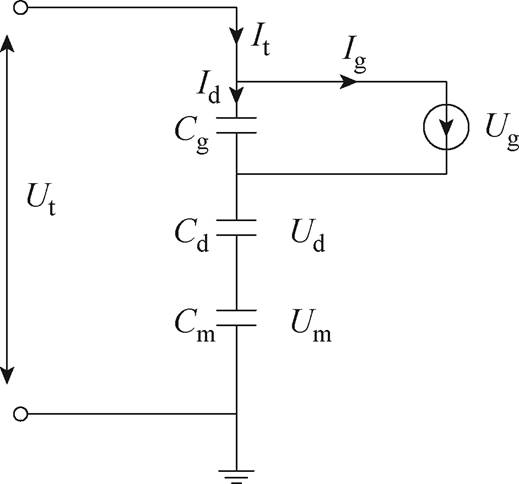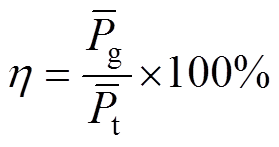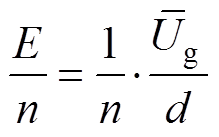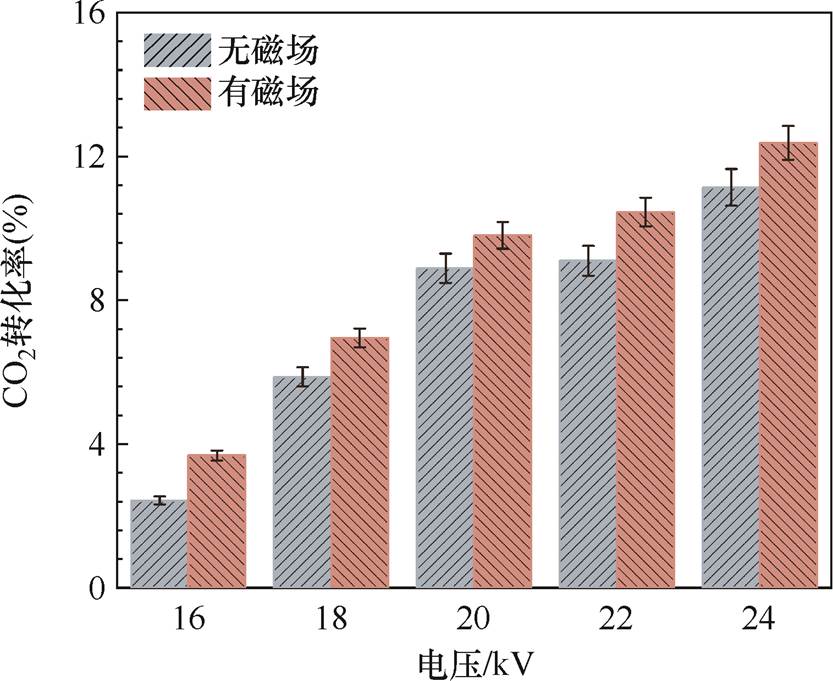
图1 试验平台及测量系统
Fig.1 Experimental platform and measurement system
摘要 大气压低温等离子体可以在常温常压条件下转化CO2,实现环境保护并促进其转化为高价值化学品和燃料的目标。目前,介质阻挡放电(DBD)在CO2转化方面备受关注,但其反应性能仍不理想。前期研究发现在DBD外施加磁场可以扩大DBD的放电区域,提高放电强度和电子密度,为提高CO2转化性能提供了新途径。该文将外部磁场作用于同轴DBD用于CO2直接分解的反应过程,研究外加磁场和反应参数对电气特性和反应性能的影响,旨在优化反应参数,提高反应性能。研究结果表明,提高电压幅值能够增强DBD放电强度,提升放电功率,产生更多活性粒子,从而提高CO2转化率,但是会降低反应过程的能量效率。外部磁场作用能够进一步增强反应区域放电强度,促进CO2分子激发解离过程的进行,从而克服部分能量损耗带来的不利影响,同时提高CO2转化率、CO产率和能量效率。在外部磁场作用下,当电压幅值为24 kV时,CO2转化率和CO产率最高,分别为12.4%和10.8%;而当电压幅值为18 kV时,能量效率最高为0.101 mmol/kJ,与未添加外部磁场时相比提高了6.4%。
关键词:外部磁场 介质阻挡放电 CO2直接分解 放电特性 能量效率
煤炭、石油和天然气等化石燃料的消耗产生了大量二氧化碳(CO2)等温室气体,引发了一系列环境问题[1]。为应对CO2排放问题的挑战,我国提出了“碳达峰”和“碳中和”的“双碳”战略目标。要实现这一目标,一方面需要推动清洁和可再生能源的开发与利用,另一方面则需要减少CO2排放[2]。碳捕集、利用与封存(Carbon Capture and Utilization, CCU)技术通过收集排放的CO2,并将其转化为可用化学原料和燃料,在减少碳排放量和实现负排放方面展现出巨大的研究及开发潜力[3-4]。然而,由于CO2具有高热稳定性,传统的CO2转化方法需要苛刻的反应条件,转化效率和能量效率都较低,难以实现商业化大规模应用[5-6]。近年来,低温等离子体技术因其能在形成过程中在局部区域产生大量活性粒子,为CO2活化和转化提供了高活性环境,具有良好的应用潜力[7-9]。
目前,用于CO2转化的等离子体技术主要包括滑动弧放电[10]、介质阻挡放电(Dielectric Barrier Discharge, DBD)[11-13]、电晕放电[14-15]和辉光放电[16]等方法。其中,DBD有着工作条件温和、放电均匀、粒子密度高及经济性优异方面的优势,在大气压和室温条件下即可产生低温等离子体[17-18],因此,在能源转化领域受到广泛关注。DBD涉及两个金属电极,其中至少一个电极被绝缘介质层所覆盖。当施加电压时,电场作用下的气体原子或分子被激发和电离,生成大量的带电粒子,是等离子体化学反应的主要驱动力。调整电极结构和操作参数可以显著影响其电气特性和化学反应性能[19-20]。DBD等离子体转化CO2的反应过程主要包括CO2直接分解、CO2加氢和CO2重整CH4等[21-22]。其中,CO2直接分解反应过程简单,主要产物CO是重要的化工原料,因而备受关注。在利用DBD等离子体进行CO2直接分解的研究中,学者主要通过改进和优化电极结构、电极材料、介质层数量、气体流速、放电频率以及使用催化剂等方式来提升CO2分解效率[17, 23-27],并取得了一系列进展,但反应物转化率和能量效率仍未达到理想状态。
近年来,纳秒脉冲电源驱动DBD在提升等离子体CO2转化反应性能方面取得了一定的效果[28]。纳秒脉冲放电具有短暂的脉冲持续时间,为气体电离过程提供了强烈的瞬时电场,能产生大量高能电子[29-30]。S.Heijkers等利用动力学模型研究纳秒脉冲放电中CO2分解转化反应机理发现,振动激发在纳秒脉冲放电转化CO2过程中起到关键作用,低振动态CO2能够通过电子激发而解离,这为CO2分解反应提供了有利的反应条件[31]。
为了进一步优化DBD放电特性并提升实际应用反应性能,研究人员尝试在DBD体系中引入外部磁场。Jiang Nan等通过在同轴DBD外施加垂直磁场研究挥发性有机化合物(Volatile Organic Compounds, VOC)降解过程的放电特性和反应性能发现,由于电子拉莫尔运动会增强原子和分子的电离反应,增强放电强度,进而提高放电区域等离子体密度,脉冲电流、甲苯去除率和能量效率均得到较大的提升[32]。Zhang Wei等研究了磁场对DBD的放电均匀性以及对NOx脱硝性能的影响,发现施加磁场能够使放电模式由丝状放电转变为分散簇状放电,进一步增强放电强度,并提升脱硝效率[33]。Jiang Weiman等比较大气压条件下有无磁场影响时的DBD放电区域发光图像观察到,在垂直磁场的作用下,等离子体射流的放电区域得到有效延长,可实现更均匀稳定的放电,主要原因在于电子在电场力与洛伦兹力的共同作用下进行直线运动的同时还沿磁力线进行圆周运动,从而增加了放电区域电子的运动路径和滞留时间,提高了与其他粒子的碰撞频率[34]。上述研究为进一步提升DBD等离子体CO2分解转化反应性能提供了思路。
本文采用磁场辅助纳秒脉冲电源驱动同轴DBD进行CO2直接分解反应,探讨外部磁场对CO2直接分解过程中放电特性和反应性能的影响。研究结果预期为揭示外部磁场对DBD放电影响机制、优化同轴DBD反应器的运行参数、提高CO2分解反应性能提供有益参考。
本文采用的试验平台及测量系统如图1所示,主要由以下部分组成:在外部磁场作用下的DBD反应器、纳秒脉冲电源、供气系统,以及用于诊断放电特性(包括电学、热力学和光学特性)和测试反应性能的设备。采用纳秒脉冲电源驱动DBD放电时,其输出电压幅值在0~30 kV之间变化,电压上升沿固定为80 ns,脉宽为250 ns,频率设定为1 kHz。

图1 试验平台及测量系统
Fig.1 Experimental platform and measurement system
DBD反应器剖面图如图2所示,主要由不锈钢金属棒内电极(高压电极)、不锈钢金属网外电极(低压电极)、钕铁硼环形磁铁和石英玻璃介质管组成。不锈钢金属棒直径为15 mm;介质管内外径分别为20 mm和23 mm;不锈钢金属网状外电极长度为8 cm;钕铁硼环形磁铁内外径分别为60 mm和100 mm,宽度为10 mm。

图2 DBD反应器剖面图
Fig.2 DBD reactor sectional view
采用数字手持高斯计(GS-25,0.01 mT)测量环形磁铁的磁感应强度,其分布如图3所示。图3中测量的是y=7.5、8.5、9.5、10.5、11.5 mm时,x轴方向距离原点O的磁感应强度分布,原点O位于环形磁铁左边缘圆心,同时固定z=0。结合DBD反应器石英玻璃介质管和内电极尺寸,可以得到放电区域磁感应强度B约为150 mT。对于外部磁场,根据拉莫尔回旋半径式(1)可知,电子在放电区域做拉莫尔运动的回旋半径Rc=4.55 nm,远小于电极间距,因此可认为外部磁场能够影响电子运动路径[34]。
 (1)
(1)
式中,q为电子的电荷量,q=1.602×10-19 C;m为电子质量,m=9.11×10-31 kg;v为带电粒子垂直磁场方向的速度,近似为电子漂移速度0.8×105 cm/s。

图3 反应器放电区域附近磁感应强度分布
Fig.3 Magnetic induction intensity distribution near the discharge region of the reactor
1.2.1 放电特性测量与诊断方法
采用图1所示系统分析诊断DBD放电过程的电学、光学和热力学特性。通过高压探头(Tek P6015A,分压比为1 000 1)测量外接电压;通过电流线圈(Pearson Electronics Inc, 6585,电流比为1 A/V)测量总电流;采用差分探头(Pintech, N1070A,分压比为1 000
1)测量外接电压;通过电流线圈(Pearson Electronics Inc, 6585,电流比为1 A/V)测量总电流;采用差分探头(Pintech, N1070A,分压比为1 000 1)测量外接电容器两端的电压,进而计算放电回路中的传输电荷等关键参数;采用示波器(Tektronix, TDS2014B)记录上述信号。通过光谱仪(Andor iStar 334)收集放电空间中的等离子体活性粒子的种类和强度信息,得到发射光谱。采用热成像仪(Fotric 320Pro)测量放电过程反应器外电极外表面的温度变化。
1)测量外接电容器两端的电压,进而计算放电回路中的传输电荷等关键参数;采用示波器(Tektronix, TDS2014B)记录上述信号。通过光谱仪(Andor iStar 334)收集放电空间中的等离子体活性粒子的种类和强度信息,得到发射光谱。采用热成像仪(Fotric 320Pro)测量放电过程反应器外电极外表面的温度变化。
为深入研究磁场辅助下DBD的电学特性,本文基于测试得到的电压电流信号数据,计算分析获得的放电功率、放电空间的电场强度、传输电荷等关键参数。DBD等效电路模型如图4所示。图中,Cg、Cd和Cm分别为气隙电容、介质层等效电容及系统外接电容。分析图4可知,可从总电压Ut中分离得到介质层电压Ud和气隙放电电压Ug;并从总电流It中分离得到放电传导电流Ig和位移电流Id。根据分离得到的瞬时电压电流参数,可以得到瞬时总功率、气隙放电功率和介质层功率,对单个放电周期内上述功率瞬时值进行积分可分别得到总平均功率 、气隙平均放电功率
、气隙平均放电功率 和介质层平均功率
和介质层平均功率 (单位均为kW)[35-36]。
(单位均为kW)[35-36]。

图4 DBD等效电路模型
Fig.4 The equivalent circuit model of DBD
激励电源能量利用率h(%)表示气隙平均放电功率占总平均功率的百分比,用来衡量等离子体反应器气体放电部分对电源输入能量利用量的大小,计算式为
 (2)
(2)
为了便于计算和分析,采用式(3)和式(4)计算得到约化场强E/n(单位为Td,1 Td=1× 10-17 V·cm2),然后用式(5)计算传输电荷量Q(mC)。
 (3)
(3)
 (4)
(4)
 (5)
(5)
式中,t1为一个周期内电流从开始出现到结束的时间;T为单个放电周期;d为放电气隙的间距;E为电场强度;n为气体分子数密度,n=2.44×1019 cm-3[37]。
1.2.2 CO2直接分解反应效果评价
本文通过气相色谱(PANNAA60)分析检测反应物和产物。CO2直接分解反应效果评价参数包括反应物CO2转化率 、产物CO产率
、产物CO产率 、反应过程的能量效率
、反应过程的能量效率 (mmol/kJ),参数的具体相关定义详见文献[38-39],计算式分别为
(mmol/kJ),参数的具体相关定义详见文献[38-39],计算式分别为
 (6)
(6)
 (7)
(7)
 (8)
(8)
式中, 、
、 、
、 分别为CO2输入的量、CO2转化的量和生成CO的量(mmol/s)。
分别为CO2输入的量、CO2转化的量和生成CO的量(mmol/s)。
本文固定纳秒脉冲电源脉冲频率、脉宽和电压上升沿等参数,从改变电压幅值入手,考察外部磁场作用对DBD分解CO2过程放电特性的影响。在气体流速为50 mL/min、外电极长度为8 cm、电压幅值为22 kV的条件下,有无磁场作用下DBD等离子体CO2直接分解的电压、电流波形如图5所示。观察图5可知,一个周期内出现两次放电过程:主放电和二次放电,分别发生在纳秒脉冲电压的上升沿和下降沿。二次放电是由主放电在放电空间和介质层表面的遗留剩余电荷造成的[40],但是由于主放电中存储的能量有限,二次放电强度远低于主放电。相比于无磁场条件,磁场的存在提升了主放电和二次放电的气隙电压峰值与传导电流幅值,其中主放电气隙电压峰值提高了13.8%。一方面,由于表面电荷和空间电荷的记忆效应,即在同一电压脉冲上升沿的主放电结束后,剩余电荷的影响使得将在后续下降沿上发生二次放电甚至三次放电,这个过程的电压波形会呈现振荡衰减的现象;另一方面,由于平行磁场对介质表面电子的约束效应,使得主放电和二次放电间隔时间范围内表面电子横向扩展减少,电子吸附和电荷中和过程减弱,表面电子消耗得更少,在这个过程中,空间带电粒子数量增加,电离效率和碰撞概率提高,生成更多的激发态活性粒子参与反应,加快了CO2分解反应的进行[41]。

图5 有无磁场作用下DBD等离子体CO2直接分解的电压、电流波形
Fig.5 Voltage and current waveforms of CO2 direct decomposition in DBD plasma with and without magnetic fields
通过波形分离得到各个部分的电压、电流波形,计算得到不同电压幅值下的总平均功率、介质层平均功率、气隙平均功率及能量利用率,结果如图6和图7所示。由图6可以看出,随着电压幅值的增加,总平均功率和气隙平均功率显著增加。电源输入能量一部分用于气隙放电,另一部分被石英玻璃介质管吸收并以热能的形式散发[42],而由于纳秒脉冲上升时间短,更多的能量被用于气体放电而不是在介质层积累,因此提高电压幅值对介质层平均功率的影响较小。由图7可知,在电压幅值较小时,能量利用率随着电压的增加而显著增大,当电压达到20 kV时,能量利用率达到最大值,之后略有下降。相较于无磁场的情况,当电压幅值为24 kV时,外加磁场使总平均功率和气隙平均功率分别提升了11.8%和12.5%、电源的能量利用率提升了5.4%。

图6 电压幅值对平均功率的影响
Fig.6 Influence of applied voltage on average power

图7 电压幅值对能量利用率的影响
Fig.7 Influence of applied voltage on energy utilization efficiency
不同电压幅值条件下气隙放电电压峰值和约化场强的变化如图8所示。在输入电压幅值较低的情况下,气隙电压低,导致约化场强较低,电子密度较小,活性粒子碰撞概率较低,不利于CO2分解反应的进行;随着输入电压幅值的增加,气隙放电电压峰值增大,约化场强显著提升,电子能量增强,反应区域活性粒子数量增加,DBD反应区域的活性粒子碰撞概率提高,从而促进CO2分解反应的进行;当电压幅值增加至18 kV时,气隙放电电压峰值和约化场强增长速度开始减缓。电压幅值对传输电荷量和气隙放电电流峰值的影响如图9所示。根据图9可得到,电压幅值的提高伴随着气隙传导电流峰值和传输电荷量的增加,这说明电压幅值可以增强电荷的产生和转移能力,增加高能电子等活性粒子的密度。引入磁场进一步增强了气隙放电电压、传导电流峰值、约化场强和传输电荷量。这表明外部磁场作用增强了放电强度和电荷产生与传输的能力,从而生成更多高能电子等活性粒子,使更多振动态CO2通过电子激发而解离[32]。添加磁场以后,放电空间中的高能电子在洛伦兹力作用下进行拉莫尔运动[43],即其在放电通道中的运动状态由直线变为螺旋运动,延长了它们在放电区域内的停留时间,有利于等离子体CO2转化过程的进行。

图8 电压幅值对气隙放电电压峰值和约化场强的影响
Fig.8 Influence of applied voltage on the peak value of gap voltage and reduced electric field

图9 电压幅值对传输电荷量和气隙放电电流峰值的影响
Fig.9 Influence of applied voltage on transferred charge and the peak value of gap conduction current
图10展示了在不同输入电压幅值条件下,有无磁场作用时,DBD等离子体CO2直接分解过程中反应器外表面最高温度的变化曲线。由图10可见,无论电压幅值如何改变,在放电前期该温度都会快速上升,随后缓慢上升,最后趋于稳定。在无外加磁场的情况下,当电压幅值为16 kV时,反应体系放电功率较低,反应器外表面最高温度随着反应的进行稳定在35℃左右;而当电压幅值为24 kV时,温度曲线在5 min内迅速上升至101℃,之后随着反应的进行缓慢趋于120℃的稳定状态。反应器外表面温度和输入电压幅值呈现正相关的变化趋势,这主要是由于提高电压幅值能够增强放电强度,同时提高施加在放电间隙的放电功率。放电功率除用于化学反应外,还会产生一定的热效应,增加反应气体的热能,这部分热能会通过介质管传递至反应器外表面与周围环境发生热交换,提高反应器外表面温度。相较于无磁场的情况,相同条件下有磁场作用时反应器外表面温度更高,这主要是由于磁场作用提高了放电强度,增加了高能电子密度和放电区域功率密度,此时活性粒子碰撞概率增加,这个过程会产生额外的热量,导致能量热损耗增加,表现为更高的外表面温度。

图10 不同电压幅值条件下CO2分解过程反应器外表面最高温度变化
Fig.10 Variations of highest temperature on the outer surface of the DBD reactor during CO2 decomposition at different voltage amplitudes
本节通过测量和计算CO2的转化率及CO的产率来评估反应效果,从而进一步优化和提升反应性能。在气体流速设定为50 mL/min且外电极长度为8 cm的条件下,图11和图12展示了有无外加磁场时,不同电压幅值对DBD等离子体直接分解CO2反应效果的影响。随着电压幅值的增加,CO2的转化率增大,CO产率提高。在无磁场作用下,当电压幅值为16 kV时,CO2的转化率和CO的产率分别为2.4%和2.5%,此时的能量效率相对较高,为0.10 mmol/kJ。从图13所示24 kV电压幅值下有无外部磁场作用的200~700 nm波长范围内的发射光谱可以看出,放电产生的活性粒子成分包括激发态的CO2和CO、 和少量O2[41, 44]。上述粒子的主要生成反应为
和少量O2[41, 44]。上述粒子的主要生成反应为
 (9)
(9)
 (10)
(10)
 (11)
(11)
 (12)
(12)
 (13)
(13)

图11 不同电压幅值条件下反应物CO2的转化率
Fig.11 The conversion of reactant CO2 at different voltage amplitudes

图12 不同电压幅值条件下产物CO的产率
Fig.12 The yield of CO at different voltage amplitudes

图13 有无磁场作用下CO2分解过程发射光谱(电压幅值:24 kV,气体流量:50 mL/min,外电极长度:8 cm)
Fig.13 Optical emission spectra of CO2 decomposition with and without magnetic field(input voltage amplitude: 24 kV, gas flow rate: 50 mL/min, length of outer electrode: 8 cm)
主要活性粒子光谱强度对比如图14所示,说明增加电压幅值能够显著提高关键活性粒子的发射光谱强度。这表明提高电场强度会产生更多高能活性粒子,提高碰撞激发和解离效率,有利于CO2分解反应的进行。在无磁场条件下,当电压幅值增加至24 kV时,CO2转化率和CO产率均达到最大值,分别为11.1%和10.7%。
由图14可知,与无磁场下CO2分解过程的发射光谱相比,添加磁场后整体光谱强度都有所增强,其中CO(313 nm)、 (337 nm)、CO2(391 nm)的光谱强度得到了显著提高,这说明外加磁场增强了放电强度并提高了活性粒子密度。这是由于一方面高能电子在洛伦兹力的作用下沿磁场方向螺旋运动,抑制了电子的径向扩散,使其与反应物分子及反应器壁面的非弹性碰撞概率降低,减少因激发/电离碰撞以外的能量耗散引起的能量损失,保持高能状态,降低高能电子损失[32];另一方面高能电子在电场力和洛伦兹力共同作用下产生漂移运动,从而延长它们在放电区域内的滞留时间[35],并增加其与活性粒子碰撞的概率,进而增强DBD放电强度,增加振动激发和电子激发态的密度,使得反应过程CO2分子激发解离程度提高,最终提升CO2分解反应性能。在外加磁场的情况下,相比于未添加磁场时,当电压幅值为22 kV时,CO2转化率提升幅度最大,为14.9%;而CO产率提升幅度则在20 kV时达到最大值11.9%。当电压幅值进一步增加至24 kV时,添加外部磁场使得CO2转化率由未添加磁场时的11.1%提升至12.4%,增幅为11.7%,此时最大的CO产率为10.8%。
(337 nm)、CO2(391 nm)的光谱强度得到了显著提高,这说明外加磁场增强了放电强度并提高了活性粒子密度。这是由于一方面高能电子在洛伦兹力的作用下沿磁场方向螺旋运动,抑制了电子的径向扩散,使其与反应物分子及反应器壁面的非弹性碰撞概率降低,减少因激发/电离碰撞以外的能量耗散引起的能量损失,保持高能状态,降低高能电子损失[32];另一方面高能电子在电场力和洛伦兹力共同作用下产生漂移运动,从而延长它们在放电区域内的滞留时间[35],并增加其与活性粒子碰撞的概率,进而增强DBD放电强度,增加振动激发和电子激发态的密度,使得反应过程CO2分子激发解离程度提高,最终提升CO2分解反应性能。在外加磁场的情况下,相比于未添加磁场时,当电压幅值为22 kV时,CO2转化率提升幅度最大,为14.9%;而CO产率提升幅度则在20 kV时达到最大值11.9%。当电压幅值进一步增加至24 kV时,添加外部磁场使得CO2转化率由未添加磁场时的11.1%提升至12.4%,增幅为11.7%,此时最大的CO产率为10.8%。

图14 主要活性粒子光谱强度对比
Fig.14 Comparison of spectral intensity of main reactive particles
图15展示了有无外加磁场时,不同电压幅值对DBD等离子体直接分解CO2过程能量效率的影响。从图15中可以明显看出,能量效率随着电压幅值的提升而降低。由1.2.1节分析可知,DBD反应器运行过程总功率主要包括介质层消耗的功率和放电气隙消耗的功率(即放电功率)。由于纳秒脉冲放电的瞬时放电功率较高,提高总功率会明显提高气隙放电功率,而对介质层消耗的功率影响不大。前期研究发现,低温下的振动激发是等离子体CO2分解转化最高效节能的反应路径[45]。在DBD等离子体中,气隙放电功率在被用于进行电子碰撞、振动、激发、解离等等离子体化学反应过程的同时,还会被用于加热反应物气体分子,提高反应器内部的温度,产生热效应,使得部分CO2分子通过热化学反应的方式来分解转化[45]。由图10中反应器外表面温度随着电压幅值的增加而明显提升的变化趋势可知,提高电压幅值会导致更多的CO2分子通过热化学反应方式分解转化,但是从热动力学化学平衡计算中发现,在本文DBD反应器运行温度条件下进行CO2分解过程的反应物转化率和能量效率是极低的[46]。此外,根据DBD反应器运行时的热传导模型分析可知[47],由于反应器内外的温度差,反应物分子的热能将通过介质管热传导至介质管外部,以对流和辐射的方式与周围环境进行热交换,并最终达到热平衡状态,造成能量损失,而不是被用于CO2的分解反应过程。并且,提高电压幅值将提高反应器温度,造成更多的能量损失,从而进一步降低能量效率。

图15 不同电压幅值条件下的能量效率
Fig.15 The energy efficiency at different voltage amplitudes
而添加外部磁场则可以提高反应过程的能量效率,这主要是由于添加外部磁场对于CO2分解过程存在两方面相互制约的作用。一方面,外部磁场会提高反应器的温度,造成一定的能量损失,对反应造成不利影响;另一方面,增加放电强度并提高活性粒子的密度有利于反应的进行。从本文结果来看,添加外部磁场的积极作用大于不利因素,从而可提高其反应过程的能量效率。本文试验过程的能量效率最大值在电压幅值为18 kV、添加外部磁场的条件下取得,为0.101 mmol/kJ,比相同条件下未添加外部磁场时提高了6.4%。后续研究将对磁场强度、磁场覆盖区域参数与放电条件参数进行优化匹配,并且研制适用的催化剂等,进一步提高磁场辅助等离子体CO2转化反应性能。
本文探讨了外部磁场作用对同轴DBD反应器中CO2直接分解反应的放电特性和反应性能的影响,测量并分析了不同电压幅值下的放电参数和CO2分解反应效果,同时讨论了相关机理。主要结论如下:
1)在同轴DBD直接分解CO2反应体系中,随着输入电压幅值的提高,放电功率显著提升,且外加磁场后,总功率和电源能量利用率得到进一步提升,在输入电压幅值为24 kV时,相较于无磁场条件,外加磁场下气隙放电电压峰值提升了13.8%,电源能量利用率提高了5.4%,有更多的能量用于等离子体CO2反应体系,从而促进CO2分解反应的进行。
2)提高输入电压幅值可显著增加反应区域活性粒子的电子能量和电子密度,且外加磁场后,电子能量和电子密度将得到进一步提升,使得反应体系内CO2激发态、电离态等活性成分提高,增大了DBD反应区域的活性粒子碰撞概率,进而促进了等离子体CO2转化反应过程,提高了CO2转化率和CO产率。与无磁场条件下的等离子体CO2转化反应体系相比,添加磁场体系在电压幅值为22 kV时CO2转化率增幅最大为14.9%,而在电压幅值为20 kV时CO产率增幅最大为11.9%。当电压幅值提高至24 kV时,添加磁场的反应体系CO2转化率和CO产率最高,分别可达到12.4%和10.8%。
3)添加外部磁场对DBD直接分解CO2过程的积极作用大于不利因素,从而能够在提升CO2转化率的同时提高整体反应的能量效率。在输入电压幅值为18 kV时,反应体系获得最大能量效率为0.101 mmol/kJ,相比未加磁场的情况提升6.4%。后续研究可以考虑优化反应体系中的宏观运行参数,选择合适的催化剂来进一步提高能量效率。
参考文献
[1] Gonzalez A, Mabon L, Agarwal A. Who wants North Sea CCS, and why? Assessing differences in opinion between oil and gas industry respondents and wider energy and environmental stakeholders[J]. Inter- national Journal of Greenhouse Gas Control, 2021, 106: 103288.
[2] Yang Song, Yang Dongzhao, Shi Wei, et al. Global evaluation of carbon neutrality and peak carbon dioxide emissions: current challenges and future outlook[J]. Environmental Science and Pollution Research International, 2023, 30(34): 81725-81744.
[3] Cuéllar-Franca R M, Azapagic A. Carbon capture, storage and utilisation technologies: a critical analysis and comparison of their life cycle environmental impacts[J]. Journal of CO2 Utilization, 2015, 9: 82-102.
[4] Liu Miao, Yi Yanhui, Wang Li, et al. Hydrogenation of carbon dioxide to value-added chemicals by heterogeneous catalysis and plasma catalysis[J]. Catalysts, 2019, 9(3): 275.
[5] George A, Shen Boxiong, Craven M, et al. A review of non-thermal plasma technology: a novel solution for CO2 conversion and utilization[J]. Renewable and Sustainable Energy Reviews, 2021, 135: 109702.
[6] Zimmermann A W, Wunderlich J, Müller L, et al. Techno-economic assessment guidelines for CO2utilization[J]. Frontiers in Energy Research, 2020, 8: 5.
[7] Ong M Y, Nomanbhay S, Kusumo F, et al. Application of microwave plasma technology to convert carbon dioxide (CO2) into high value products: a review[J]. Journal of Cleaner Production, 2022, 336: 130447.
[8] 陈慧敏, 段戈辉, 梅丹华, 等. 气体添加对水电极同轴介质阻挡放电直接分解CO2的影响[J]. 电工技术学报, 2023, 38(1): 270-280.
Chen Huimin, Duan Gehui, Mei Danhua, et al. Effect of gas addition on CO2 decomposition in a coaxial dielectric barrier discharge reactor with water electrode[J]. Transactions of China Electrotechnical Society, 2023, 38(1): 270-280.
[9] 李天宇, 孙静, 高钰婷, 等. 等离子体催化及其在电力多元转换的应用研究进展[J]. 电工技术学报, 2024, 39(17): 5461-5481.
Li Tianyu, Sun Jing, Gao Yuting, et al. Research progress on plasma catalysis and its applications in power-to-X[J]. Transactions of China Electrotechni- cal Society, 2024, 39(17): 5461-5481.
[10] 刘洋, 章子潇, 赵贤根, 等. 进气流量对滑动电弧放电分解CO2的瞬态电-光-热特性和转化性能的影响[J]. 电工技术学报, 2024, 39(23): 7616-7627.
Liu Yang, Zhang Zixiao, Zhao Xiangen, et al. The effect of inlet flow rate on the transient electrical- optical-thermal characteristics and conversion perfor- mance of CO2 decomposition in gliding arc discharges [J]. Transactions of China Electrotechnical Society, 2024, 39(23): 7616-7627.
[11] Dey G R, Kamble S. Effects of electrode material and frequency on carbon monoxide formation in carbon dioxide dielectric barrier discharge[J]. Journal of CO2 Utilization, 2020, 40: 101207.
[12] Lu Na, Zhang Chuke, Shang Kefeng, et al. Dielectric barrier discharge plasma assisted CO2 conversion: understanding the effects of reactor design and operating parameters[J]. Journal of Physics D: Applied Physics, 2019, 52(22): 224003.
[13] Umamaheswara Rao M, Bhargavi K V S S, Chawdhury P, et al. Non-thermal plasma assisted CO2 conversion to CO: influence of non-catalytic glass packing materials[J]. Chemical Engineering Science, 2023, 267: 118376.
[14] Pornmai K, Ngamkala W, Rirksomboon T, et al. Re- forming of CO2-containing natural gas with steam and partial oxidation over Ni catalysts in corona discharge for synthesis gas production[J]. Industrial & Engineering Chemistry Research, 2019, 58(16): 6203-6217.
[15] Moss M S, Yanallah K, Allen R K, et al. An investigation of CO2 splitting using nanosecond pulsed corona discharge: effect of argon addition on CO2 conversion and energy efficiency[J]. Plasma Sources Science and Technology, 2017, 26(3): 035009.
[16] Meng Guodong, Xia Linghan, Cheng Yonghong, et al. AC-driven atmospheric pressure glow discharge co- improves conversion and energy efficiency of CO2 splitting[J]. Journal of CO2 Utilization, 2023, 70: 102447.
[17] 孙闵杰, 付军辉, 刘泓麟, 等. 分段电极介质阻挡放电CO2重整CH4过程放电特性与反应性能研究[J]. 电工技术学报, 2023, 38(15): 3972-3983.
Sun Minjie, Fu Junhui, Liu Honglin, et al. Discharge characteristics and reaction performance of CH4 reforming with CO2 in dielectric barrier discharge with segmented electrodes[J]. Transactions of China Electrotechnical Society, 2023, 38(15): 3972-3983.
[18] He Junwen, Peng Bangfa, Yu Guanglin, et al. Experimental and numerical study on atmospheric- pressure air dielectric barrier discharge via 50 Hz/ 5 000 Hz dual-frequency excitation[J]. High Voltage, 2024, 9(2): 391-402.
[19] 卢洪伟, 倪志娇, 查学军. 不同电极结构对DBD降解亚甲基蓝废水的影响[J]. 高压电器, 2023, 59(4): 62-69.
Lu Hongwei, Ni Zhijiao, Zha Xuejun. Effect of different electrode structures on degradation of methylene blue wastewater by DBD plasma[J]. High Voltage Apparatus, 2023, 59(4): 62-69.
[20] 张国治, 王文祥, 张磊, 等. 介质阻挡放电等离子体处理变压器废弃绝缘油的实验探究[J]. 电工技术学报, 2025, 40(1): 325-334.
Zhang Guozhi, Wang Wenxiang, Zhang Lei, et al. Experimental exploration of dielectric barrier discharge plasma treatment of transformer waste insulating oil[J]. Transactions of China Electrotechni- cal Society, 2025, 40(1): 325-334.
[21] Gao Xingyuan, Liang Jinglong, Wu Liqing, et al. Dielectric barrier discharge plasma-assisted catalytic CO2 hydrogenation: synergy of catalyst and plasma [J]. Catalysts, 2022, 12(1): 66.
[22] Rao M U, Vidyasagar D, Rangappa H S, et al. Recent advances on CO2 conversion into value added fuels by non-thermal plasma[J]. Catalysis Today, 2024, 441: 114887.
[23] Mei Danhua, Tu Xin. Conversion of CO2 in a cylindrical dielectric barrier discharge reactor: Effects of plasma processing parameters and reactor design [J]. Journal of CO2 Utilization, 2017, 19: 68-78.
[24] Khunda D, Li Sirui, Cherkasov N, et al. Scaling down the great Egypt Pyramids to enhance CO2 splitting in a micro DBD reactor[J]. Plasma Chemistry and Plasma Processing, 2023, 43(6): 2017-2034.
[25] Nozaki T, Chen Xiaozhong, Kim D Y, et al. Combination of DBD and catalysts for CH4 and CO2 conversion: basics and applications[J]. Plasma Chemistry and Plasma Processing, 2023, 43(6): 1385- 1410.
[26] Hosseini Rad R, Brüser V, Schiorlin M, et al. Enhancement of CO2 splitting in a coaxial dielectric barrier discharge by pressure increase, packed bed and catalyst addition[J]. Chemical Engineering Journal, 2023, 456: 141072.
[27] Liu Changyu, Wang Haixing, Wang Chao, et al. Experimental study of the effect of dielectric materials on the decomposition of carbon dioxide in a dielectric barrier discharge[J]. Plasma Sources Science Technology, 2023, 32(2): 025011.
[28] 邵涛, 张帅, 章程, 等. 可再生能源驱动放电等离子体助推双碳目标策略与路线[J]. 中国电机工程学报, 2024, 44(18): 7453-7479.
Shao Tao, Zhang Shuai, Zhang Cheng, et al. The strategy and route of renewable energy driven discharge plasma boosting the carbon peak and carbon neutrality[J]. Proceedings of the CSEE, 2024, 44(18): 7453-7479.
[29] 杨勇, 梅丹华, 段戈辉, 等. 不同电源激励Ar同轴介质阻挡放电特性对比[J]. 高电压技术, 2020, 46(12): 4355-4364.
Yang Yong, Mei Danhua, Duan Gehui, et al. Comparison of discharge characteristics of Ar coaxial dielectric barrier discharge dirven by different power supplies[J]. High Voltage Engineering, 2020, 46(12): 4355-4364.
[30] 王晓玲, 高远, 张帅, 等. 脉冲参数对介质阻挡放电等离子体CH4干重整特性影响的实验[J]. 电工技术学报, 2019, 34(6): 1329-1337.
Wang Xiaoling, Gao Yuan, Zhang Shuai, et al. Effects of pulse parameters on dry reforming of CH4 by pulsed DBD plasma[J]. Transactions of China Electrotechni- cal Society, 2019, 34(6): 1329-1337.
[31] Heijkers S, Martini L M, Dilecce G, et al. Nanosecondpulsed discharge for CO2 conversion: kinetic modeling to elucidate the chemistry and improve the perfor- mance[J]. The Journal of Physical Chemistry C, 2019, 123(19): 12104-12116.
[32] Jiang Nan, Sun Yun, Peng Bangfa, et al. Promoting volatile organic compounds removal by a magnetically assisted nanosecond pulsed gear-cylinder dielectric barrier discharge[J]. Plasma Processes and Polymers, 2022, 19(3): e2100108.
[33] Zhang Wei, Ji Yulong, Zhang Jifeng, et al. Magnetic field and dielectric beads modulate DBD reduced electric field with discharge homogeneity to realize NOx differential conversion[J]. Journal of Environ- mental Chemical Engineering, 2024, 12(5): 113712.
[34] Jiang Weiman, Tang Jie, Wang Yishan, et al. A low- power magnetic-field-assisted plasma jet generated by dielectric-barrier discharge enhanced direct-current glow discharge at atmospheric pressure [J]. Applied Physics Letters, 2014, 104(1): 013505.
[35] 刘一荻. 平行磁场对大气压纳秒脉冲放电等离子体影响的实验研究[D]. 大连: 大连理工大学, 2018.
Liu Yidi. Experimental investigations about effects of parallel magnetic field on plasmas produced by nanosecond pulsed discharge at atmospheric pressure [D]. Dalian: Dalian University of Technology, 2018.
[36] 李梦遥, 王歆昀, 赵昱雷, 等. 纳秒脉冲电压幅值和上升/下降沿时间对大气压氮气DBD均匀性的影响[J]. 高电压技术, 2024, 50(2): 852-860.
Li Mengyao, Wang Xinyun, Zhao Yulei, et al. Influence of nanosecond pulse voltage amplitude and rising/falling edge time on the uniformity of atmos- pheric pressure N2 DBD[J]. High Voltage Engineering, 2024, 50(2): 852-860.
[37] 杜军, 李嘉聪, 高远, 等. 脉冲等离子体驱动CO2加氢制备CH3OH电学参数调控对转化特性的影响[J]. 高电压技术, 2023, 49(8): 3275-3285.
Du Jun, Li Jiacong, Gao Yuan, et al. Effect of electrical parameters on conversion characteristics of CO2 hydrogenation to CH3OH by pulsed plasma[J]. High Voltage Engineering, 2023, 49(8): 3275-3285.
[38] Mei Danhua, Zhu Xinbo, He Yaling, et al. Plasma- assisted conversion of CO2 in a dielectric barrier discharge reactor: understanding the effect of packing materials[J]. Plasma Sources Science and Technology, 2015, 24(1): 015011.
[39] Mei Danhua, Duan Gehui, Fu Junhui, et al. CO2 reforming of CH4 in single and double dielectric barrier discharge reactors: Comparison of discharge characteristics and product distribution[J]. Journal of CO2 Utilization, 2021, 53: 101703.
[40] Qi Haicheng, Fan Zhihui, Liu Yidi, et al. Investigation of nanosecond pulsed dielectric barrier discharge using plate-to-plate electrode with asymmetric dielectric arrangement in airflow[J]. Physics of Plasmas, 2016, 23(5): 053509.
[41] Damideh V, Chin O H, Gabbar H A, et al. Study of ozone concentration from CO2 decomposition in a water cooled coaxial dielectric barrier discharge[J]. Vacuum, 2020, 177: 109370.
[42] Duan Gehui, Fang Zhi, Fu Junhui, et al. Influence of water cooling for outer electrode on the discharge characteristics of an atmospheric coaxial DBD reactor [J]. IEEE Transactions on Plasma Science, 2021, 49(3): 1173-1180.
[43] 李平, 彭超, 陶华杨, 等. 磁场增强DBD等离子体改善煤炭燃烧的特性[J]. 高电压技术, 2023, 49(10): 4436-4444.
Li Ping, Peng Chao, Tao Huayang, et al. Improving coal combustion characteristics by magnetic field enhanced DBD plasma[J]. High Voltage Engineering, 2023, 49(10): 4436-4444.
[44] Barkhordari A, Karimian S, Rodero A, et al. Carbon dioxide decomposition by a parallel-plate plasma reactor: experiments and 2-D modelling[J]. Applied Sciences, 2021, 11(21): 10047.
[45] Bogaerts A, Berthelot A, Heijkers S, et al. CO2 conversion by plasma technology: insights from modeling the plasma chemistry and plasma reactor design[J]. Plasma Sources Science and Technology, 2017, 26(6): 063001.
[46] Mei Danhua, Tu Xin. Atmospheric pressure non- thermal plasma activation of CO2 in a packed-bed dielectric barrier discharge reactor[J]. ChemPhys- Chem, 2017, 18(22): 3253-3259.
[47] Miao Chuanrun, Liu Feng, Wang Qian, et al. Investigation on the influence of electrode geometry on characteristics of coaxial dielectric barrier discharge reactor driven by an oscillating microsecond pulsed power supply[J]. The European Physical Journal D, 2018, 72(3): 57.
Abstract Direct CO2 decomposition is a typical form to convert CO2 into valuable chemical feedstocks and fuels. However, stringent reaction conditions are required in the conventional methods due to the intrinsic thermal stability of CO2, which frequently result in suboptimal conversion and energy efficiencies. Low- temperature plasma technology (e.g., dielectric barrier discharge, DBD) offers a highly reactive environment for the activation and conversion of CO2. CO2 decomposition in DBD has been a hot topic, but its reaction performance is still not satisfactory. Introducing an external magnetic field into DBD can enhance discharge intensity, and consequently improve the performance for practical applications, which presents an innovative approach to improve CO2 decomposition performance. Nonetheless, there is limited research on the effects of magnetic fields on the discharge characteristics of DBD and the corresponding CO2 decomposition performance. The optimization of reaction parameters has yet to be clearly established, and underlying mechanisms have not been deeply understood. Herein, a comprehensive investigation has been performed on CO2 decomposition in DBD enhanced by magnetic field.
The DBD reactor comprises the stainless steel inner rod and outer mesh electrodes, the NdFeB ring magnet, and the quartz dielectric tube. It is powered by a nanosecond pulsed power supply. The outer electrode is grounded after connected to a reference capacitor. Voltage and current measurements are obtained using a Tektronix high voltage probe, a Pin-tech voltage probe and a Pearson current coil, respectively. All signals are recorded using a Tektronix digital oscilloscope. Electrical characteristics are derived from voltage-current waveform analysis and the equivalent circuit model of DBD. An Andor spectrometer has been employed to identify the type and intensity of reactive species within the discharge space. Additionally, a Fotric thermal imaging device has been utilized to quantify temperature variations outside the reactor during discharge. The discharge characteristics has been discussed based on the results of electrical, optical and temperature characteristics. A PANNA gas chromatography has been utilized to analyze the gaseous components before and after the reaction. Reaction performance has been evaluated based on the conversion of CO2 to CO and the overall process energy efficiency.
The following conclusions can be drawn from the study: (1) In the coaxial DBD system for the direct CO2 decomposition, increasing the voltage amplitude results in a significant enhancement in discharge power. Introducing a magnetic field leads to further improvements in total power and energy utilization efficiency of the power supply. In the presence of a magnetic field, the peak value of the gap voltage and the energy utilization efficiency have been achieved at the voltage amplitude of 24 kV. (2) The presence of a magnetic field enhances the discharge intensity and promote the production of energetic electrons and other reactive species, which increases their possibility of collisions with CO2 molecules, leading to the increase in both CO2 conversion and CO yield. Introducing the magnetic field leads to the largest enhancement of 14.9% for CO2 conversion when the voltage amplitude is 22 kV, while the largest enhancement for CO yield (11.9%) at the voltage amplitude of 20 kV. (3) The positive influence of magnetic field on CO2 decomposition surpasses the negative influence of the resulted heat loss, which promotes the overall energy efficiency while increasing CO2 conversion. The maximum energy efficiency of 0.101 mmol/kJ is achieved at an input voltage amplitude of 18 kV, which is increased by 6.4% compared to that obtained in the absence of a magnetic field. Further enhancement in the process energy is expected to be achieved by the optimization of the operating parameters and the development of suitable catalysts.
keywords:External magnetic field, dielectric barrier discharge, direct CO2 decomposition, discharge characteristics, energy efficiency
DOI: 10.19595/j.cnki.1000-6753.tces.241853
中图分类号:TM85
国家自然科学基金面上项目资助(52177149)。
收稿日期 2024-10-21
改稿日期 2025-01-19
吕锡昂 男,1998年生,硕士研究生,研究方向为大气压低温等离子体特性诊断及能源转化应用。E-mail: lvjojo589426@163.com
梅丹华 男,1985年生,教授,硕士生导师,研究方向为高电压与气体放电等离子体技术及其能源环境应用。E-mail: danhuam@126.com(通信作者)
(编辑 李 冰)